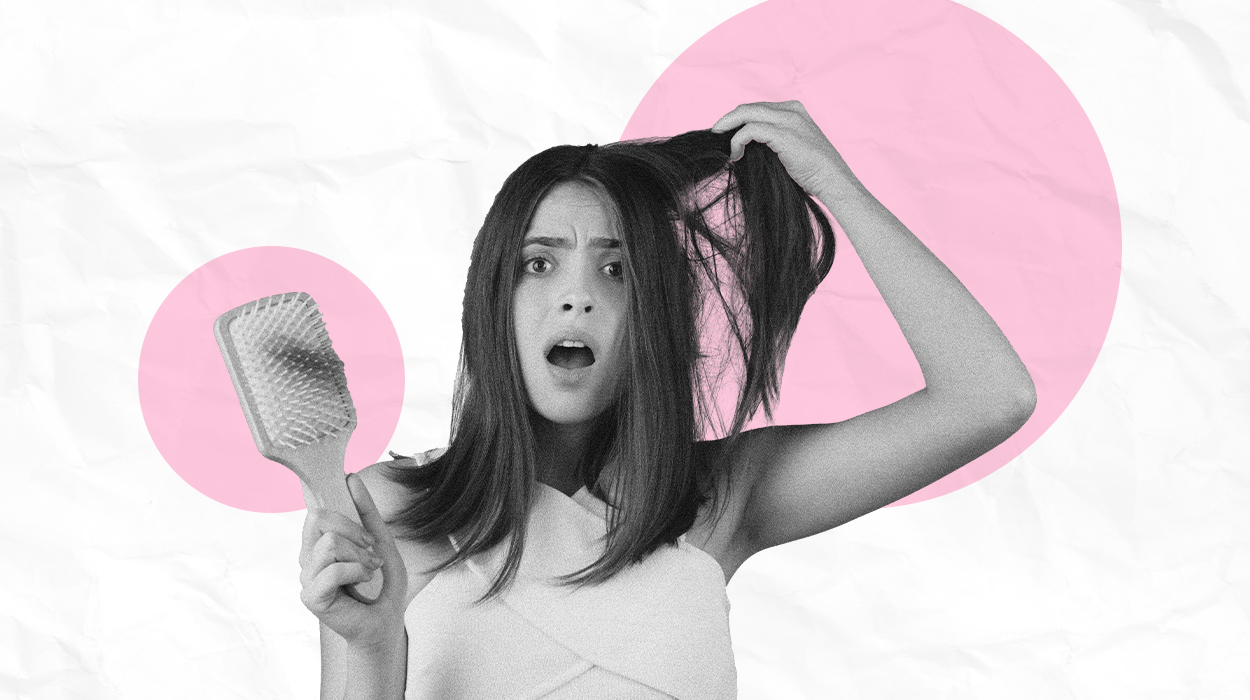 Expert's opinion
Expert's opinion
Expert's opinion
The article is a subjective view on this topic written by writers specializing in medical writing.
It may reflect on a personal journey surrounding struggles with an illness or medical condition, involve product comparisons, diet considerations, or other health-related opinions.
Although the view is entirely that of the writer, it is based on academic experiences and scientific research they have conducted; it is fact-checked by a team of degreed medical experts, and validated by sources attached to the article.
The numbers in parenthesis (1,2,3) will take you to clickable links to related scientific papers.
How Much Hair Loss Is Normal? Here’s The Answer In 2024

Hair loss, a common concern affecting millions of individuals worldwide, is a topic shrouded in misconceptions. While hair shedding is a normal and natural part of our body’s hair growth cycle, there is a point where the amount of hair being shed could be considered excessive.
Age, genetics, hormones, and even external factors like stress can significantly influence the rate and amount of hair loss and hair growth. Understanding how much hair loss is normal, and recognizing what is considered excessive hair loss, are essential steps in maintaining optimal hair health and seeking necessary interventions if required.
So, if you are asking yourself: Why am I losing so much hair? Or if you are wondering how much hair shedding is normal, this article is for you.
How Much Hair Hair Loss Is Normal?
Determining how much hair shedding is considered “excessive” depends on individual factors like hair density, lifestyle, and genetics. How much hair do you lose a day? Generally speaking, it is normal to lose fifty to one hundred and fifty[1] hairs from our scalp each day, depending on the hair length and thickness of the hair. However, exceeding these numbers consistently may be a cause for concern.
Losing more than 150 hairs of average hair loss per day consistently, noticing visible thinning or bald patches, or experiencing rapid hair loss within a short timeframe warrants further investigation by a healthcare professional or dermatologist. They can provide a personalized assessment, diagnosis, and treatment plan to address the specific issue causing hair loss.
Hair Loss When In The Shower
You may notice that most of your hair shedding happens while you are in the shower. This does not necessarily mean that showering is causing your hair to fall out, but rather it is rinsing out trapped hairs that have already detached from the follicle. Keep an eye out for excessive hair in the shower drain, but if you stay within the 50 to 150 hair count, there is probably nothing to worry about.
The frequency of hair washing and the quality of hair products may be contributing to hair loss, however. Washing your hair too infrequently[2] can cause a build-up and inflammation on the scalp, leaving hair more prone to breakage.
Hair Loss When Brushing Hair

There isn’t a normal regarding how much hair should be in your brush after use. It will depend on the frequency that you brush, as well as the hair length and condition.
Some older studies[3] have found that brushing hair frequently can increase the amount of hair shedding in a day, though there have not been any recent studies on the topic. As a general guide, if you are left with much more hair than usual on your brush over several days, it may be time to visit the doctor.
Hair Loss For A Child
Numerous factors, such as telogen effluvium, tinea on the scalp, and bacterial infections, can cause lost hair in children. Fever, traction alopecia, trichotillomania from pulling hair, and alopecia areata are all medical conditions relative to hair loss in children.
If a child begins to lose more hair than the average 100 or so strands, it could be considered more than normal hair fall, and you may want to visit your healthcare provider.
Causes Of Excessive Hair Fall
Numerous factors, ranging from genetics to environmental conditions, may contribute to excessive hair fall.
- Hormonal fluctuations are among the most common factors behind excessive hair fall[4] in both men and women. In particular, women may experience hair loss during pregnancy or menopause due to changes in estrogen and progesterone levels. Similarly, polycystic ovary syndrome and thyroid disorders can disrupt hormonal balance, resulting in hair loss.
- Certain nutrient deficiencies,[5] such as iron, zinc, and protein, can lead to excess hair shedding. Additionally, a lack of essential fatty acids[6] or an improper balance of vitamins and minerals can weaken the hair follicle and cause hair to become brittle, leading to breakage and shedding.
- Physical and emotional stress can negatively affect the hair growth[7] cycle, resulting in hair fall. Telogen effluvium, for example, is a temporary hair loss condition triggered by extreme stress or a traumatic event, causing hair follicles to enter the resting phase prematurely and eventually cause excessive hair shedding.
- Hereditary hair loss or androgenetic alopecia is a common cause of hair fall[8] in both men and women. This condition is associated with a genetic predisposition to hair follicles’ sensitivity to dihydrotestosterone, a hormonal byproduct of testosterone that can cause hair follicles to shrink and eventually stop producing new hair.
- Certain medications, such as chemotherapy[9] for cancer, can induce temporary or permanent hair loss due to their effects on the hair follicles.
- Use of harsh chemical treatments[10] or excessive heat stylings, such as hair dyes, perms, relaxers, and the use of flat irons, can damage hair, leading to breakage and excess hair fall.
- As individuals age,[11] hair growth naturally slows down, and hair follicles become less active, leading to thinning and hair shedding.
- Exposure to environmental pollutants,[12] harsh weather conditions, and ultraviolet radiation can damage hair, contributing to hair fall.
How To Prevent Hair Loss?
When it comes to preventing hair loss, the most important thing to do is to identify what is causing yours so you can treat the right thing. To cover all your bases, eating nutritious food, managing stress, balancing your hormones, and avoiding chemicals and pollutants that might damage your hair would be a great start.
Consuming sufficient vitamins and minerals like iron, zinc, vitamin D, and protein can help strengthen hair follicles and minimize hair loss. Including foods rich in these nutrients, such as dark leafy greens, nuts, seeds, fatty fish, and whole grains, can offer significant benefits.
Ensuring that our hormonal levels are appropriately balanced can help reduce the risk of hair loss. Consult with a healthcare professional if you suspect a hormonal imbalance is causing your hair loss, and they can guide you through the necessary tests and treatments.
Chronic stress has been linked to hair loss, as it may disrupt the hair growth cycle. Stress-management techniques like deep breathing, meditation, yoga, or engaging in hobbies that help relax the mind can mitigate stress-induced hair loss, and supplement your diet with nutraceuticals such as ashwagandha or L-theanine.
Avoid aggressive brushing, tight hairstyles, and excessive use of heat-styling tools to prevent damage to the hair shaft and follicles. Always brush your hair gently using a wide-tooth comb, especially when wet, as it is more prone to breakage.
If you’re struggling with hair loss, taking supplements designed for hair growth, such as the B vitamins and vitamin C, may provide additional support. These supplements typically contain essential nutrients known to support healthy hair growth.
Before beginning any supplement regimen, consult your healthcare professional, such as a registered dietitian, to determine the best action plan for your specific needs.
When To See A Doctor?

Generally speaking, if your hair loss is sudden or occurs in patches, it is more likely due to an underlying medical condition and should be checked out by a doctor. Other signs that may warrant medical attention include itching or burning scalp, scalp sores that won’t heal, extreme and sudden hair thinning, or gradual thinning over time.
Hair loss can have emotional consequences, so it is important not to ignore signs of sudden or abnormal hair shedding and to seek medical advice early on to improve the chances of success with treatments. It may also be helpful to bring the hair you have shed in a clear plastic bag so they can utilize a hair-shedding visual scale to get an idea of how much you are losing. Sometimes we over or underestimate what might be perfectly normal!
Takeaway
Understanding the normalcy of hair loss is vital in distinguishing between natural shedding and abnormal hair thinning. Factors such as age, gender, genetics, hair length, and hair condition play significant roles in determining the rate of hair loss.
It is essential to monitor and assess the hair strands left in your hair comb, brush, or pillow to gauge if the shedding sits around 50 and 150 hairs per day and book an appointment with a doctor or dermatologist if you notice sudden changes in your shedding levels or scalp condition.
+ 12 sources
Health Canal avoids using tertiary references. We have strict sourcing guidelines and rely on peer-reviewed studies, academic researches from medical associations and institutions. To ensure the accuracy of articles in Health Canal, you can read more about the editorial process here
- Kovacevic, M., Goren, A., Shapiro, J., Sinclair, R., Lonky, N.M., Situm, M., Bulat, V., Bolanca, Z. and McCoy, J. (2016). Prevalence of hair shedding among women. Dermatologic Therapy, [online] 30(1), p.e12415. Available at: https://www.ncbi.nlm.nih.gov/pmc/articles/PMC6175177/
- Punyani, S., Tosti, A., Hordinsky, M., Yeomans, D. and Schwartz, J. (2021). The Impact of Shampoo Wash Frequency on Scalp and Hair Conditions. Skin Appendage Disorders, [online] 7(3), pp.183–193. Available at: https://www.ncbi.nlm.nih.gov/pmc/articles/PMC8138261/
- Kiderman, A., Gur, I. and Ever-Hadani, P. (2009). The effect of brushing on hair loss in women. Journal of Dermatological Treatment, [online] 20(3), pp.152–155. Available at: https://pubmed.ncbi.nlm.nih.gov/19016066/
- Brough, K.R. and Torgerson, R.R. (2017). Hormonal therapy in female pattern hair loss. International Journal of Women’s Dermatology, [online] 3(1), pp.53–57. Available at: https://www.ncbi.nlm.nih.gov/pmc/articles/PMC5419033/
- Almohanna, H.M., Ahmed, A.A., Tsatalis, J.P. and Tosti, A. (2018). The Role of Vitamins and Minerals in Hair Loss: A Review. Dermatology and Therapy, [online] 9(1), pp.51–70. Available at: https://www.ncbi.nlm.nih.gov/pmc/articles/PMC6380979/
- Le Floc’h, C., Cheniti, A., Connétable, S., Piccardi, N., Vincenzi, C. and Tosti, A. (2015). Effect of a nutritional supplement on hair loss in women. Journal of Cosmetic Dermatology, [online] 14(1), pp.76–82. Available at: https://pubmed.ncbi.nlm.nih.gov/25573272/
- Peters, E.M.J., Müller, Y., Snaga, W., Fliege, H., Reißhauer, A., Schmidt-Rose, T., Max, H., Schweiger, D., Rose, M. and Kruse, J. (2017). Hair and stress: A pilot study of hair and cytokine balance alteration in healthy young women under major exam stress. PLOS ONE, [online] 12(4), p.e0175904. Available at: https://www.ncbi.nlm.nih.gov/pmc/articles/PMC5397031/
- Ustuner, E.T. (2013). Cause of Androgenic Alopecia. Plastic and Reconstructive Surgery Global Open, [online] 1(7), p.e64. Available at: https://www.ncbi.nlm.nih.gov/pmc/articles/PMC4174066/
- Chopra, A., Saraswat, N., Sood, A., Kamboj, P. and Kumar, S. (2019). A descriptive study to analyze chemotherapy-induced hair loss and its psychosocial impact in adults: Our experience from a tertiary care hospital. Indian Dermatology Online Journal, [online] 10(4), p.426. Available at: https://www.ncbi.nlm.nih.gov/pmc/articles/PMC6615375/
- Hatsbach de Paula, J.N., Basílio, F.M.A. and Mulinari-Brenner, F.A. (2022). Effects of chemical straighteners on the hair shaft and scalp. Anais Brasileiros de Dermatologia, [online] 97(2), pp.193–203. Available at: https://www.sciencedirect.com/science/article/pii/S0365059621003147
- Fabbrocini, G., Cantelli, M., Masarà, A., Annunziata, M.C., Marasca, C. and Cacciapuoti, S. (2018). Female pattern hair loss: A clinical, pathophysiologic, and therapeutic review. International Journal of Women’s Dermatology, [online] 4(4), pp.203–211. Available at: https://www.sciencedirect.com/science/article/pii/S2352647518300224
- Naudin, G., Bastien, P., Mezzache, S., Trehu, E., Bourokba, N., Appenzeller, B.M.R., Soeur, J. and Bornschlögl, T. (2019). Human pollution exposure correlates with accelerated ultrastructural degradation of hair fibers. Proceedings of the National Academy of Sciences, [online] 116(37), pp.18410–18415. Available at: https://www.ncbi.nlm.nih.gov/pmc/articles/PMC6744867/



